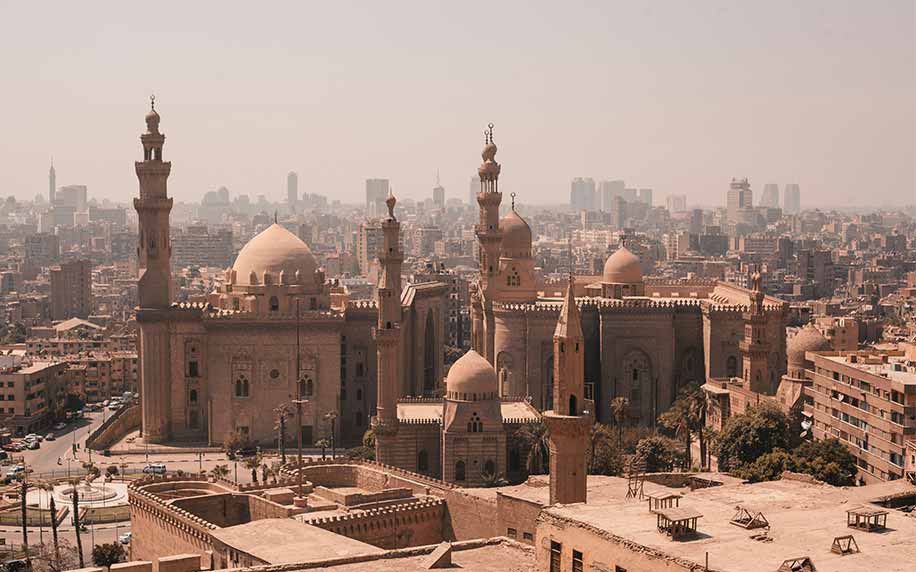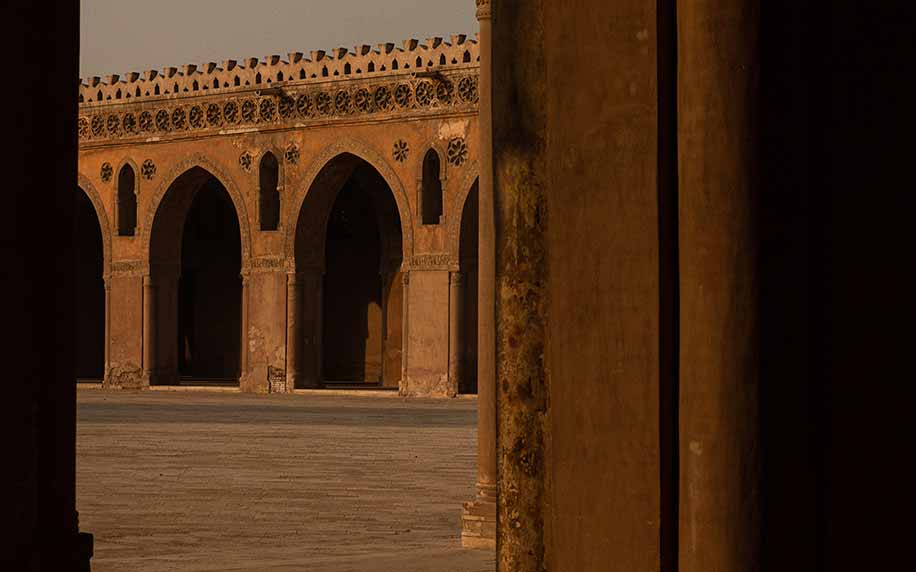Saladin Citadel and Muhammad Ali Mosque

Updated On: March 21, 2024 by Dina Essawy
A magnificent landmark in Cairo, the capital of Egypt, is the Citadel of Cairo or the Citadel of Saladin where the rulers of Egypt lived and ruled from the Citadel for close to 700 years, from the 13th to the 19th centuries. This Islamic-era fort was built by Salah ad-Din (Saladin) in 1176, the first sultan of Egypt who led a military campaign against the Crusaders.
Who is Saladin?
Saladin was born in 1137/38 in Tikrīt, Mesopotamia (modern-day Iraq). He was the Sultan of Egypt, along with Syria, Yemen, and Palestine, and he was the founder of the Ayyūbid dynasty. He fought against the Crusaders and won, capturing Jerusalem.
He strengthened the fortifications of Cairo by building the Cairo Citadel, which is now more popularly known as Saladin Citadel, and extended the city walls.

Location and Design
The Citadel of Cairo was built in a very prominent position and strategic position on the Mokattam hills near the center of Cairo, so it overlooks the entire city. It is definitely one of the most impressive military fortifications of its time due to its location and layout.
As it stands today, Saladin Citadel has four gates, El-Mokatam gate, the New Gate, the Middle Gate, and the Citadel gate, and about thirteen towers and four palaces, including Palace Ablaq and Al-Gawhara Palace.
After Saladin, the Citadel went through major development during the Mamluk Sultanate, until the reign of Sultan al-Nasir Muhammad in the 14th century. During the 19th century, Muhammad Ali Pasha tor down some of the older buildings and replaced them with new palaces that you can see today.
In the 20th century, the citadel was sometimes utilized by the British occupation forces as a military garrison, and then so did the Egyptian army, until it was opened to the public in 1983. In 1976, the Citadel was proclaimed as a World Heritage Site by UNESCO.
Throughout its history, the Citadel went through three main construction periods: the Ayyubid Era in the 12th century (during Saladin’s reign), the Mamluk era in the 14th century (under al-Nasir Muhammad), and during the reign of Muhammad Ali in the 19th century.
The overall complex is divided into two main sections, which are the Northern Enclosure (where you can now find the Military Museum), and the Southern Enclosure (where you can find the Mosque of Muhammad Ali Pasha).
The Northern Enclosure was usually employed by military personnel, while the Southern Enclosure was the residence of the sultan. There is also another enclosure where the royal stables of the Mamluks were kept. However, these functional distinctions were largely erased in the 19th century under Muhammad Ali Pasha, who removed the entire site and constructed buildings used for various functions.
An open field lies to the west of the Citadel that was a training ground and a military parade ground. At the northern end of this field was another square known as Rumayla Square that was used as a horse market because it was close to the royal stables. Some royal and religious ceremonies were also held there. Now, it is a large roundabout known as the Citadel Square next to the historical mosques of Sultan Hassan and al-Rifa’i.
Foundation of the Castle in the Ayyubid Period during the 12th Century
The construction of the Citadel was ordered by the Kurdish Ayyubid ruler Saladin between 1176 and 1183 as a fortification to protect the city from Crusaders and to become the location from which the government ruled the country.
To do so, they also proceeded to build a 20-kilometre wall that would surround both Cairo and the former capital, Fustat, with the Citadel in the centre. While the Citadel was completed in 1183–1184, the wall’s construction continued long after Saladin’s death and appears to not have been completed.
Most of the structure of the Citadel is made with limestone. Bab al-Mudarraj is the only original gate that has survived till today. It can be found within the walls of the Northern Enclosure, which nowadays lies between the Harem Palace (National Military Museum) and the newer Bab al-Jadid gate (New Gate). It was originally the main gate of the Citadel, and its name comes from the stone steps (darraj) that led up to it from the path that connected the Citadel to the city below. On this particular gate, a foundation inscription was discovered which specifies the date of completion of the Citadel to the years 1183-1184.
Saladin’s successors continued to add to the construction of the Citadel in one way or another including Sultan al-‘Adil, Saladin’s brother and successor, who reigned from 1200 to 1218, and it was probably finished under the reign of al-Kamil (1218-1238).
The rounded towers in the Northern Enclosure date back to Saladin’s era, while the large rectangular towers date to al-Adil’s reign. The two round towers are known as Burj al-Ramla (“Tower of Sand”) and Burj al-Hadid (“Tower of Iron”) and they date back to Saladin’s time but were reinforced later on.
The most significant construction done by Sultan al-Kamil were the palaces in the southern section of the Citadel, as he became the first ruler to actually move there in 1206. He also built a mosque, a royal library, a “hall of justice”, and a horse market on what became Rumayla Square (the square between the Citadel and Sultan Hassan’s mosque today), as well as the square to the west and south of the Citadel which was used for training and military parades.
Al-Kamil was also built the first water aqueduct that ran along the top of the city walls to transfer water from the Nile to the Citadel.
Afterwards, Sultan al-Salih, who ruled from 1240 to 1249, moved away from the Citadel and built a new fort on Roda Island, but the Mamluks, who ruled from 1250 to 1517, the Citadel become the permanent residence of the sultans.
The Citadel in the Mamluk Period from the 13th to the 16th Century
The Bahri Mamluks continued to develop the Citadel as they expanded the Southern Enclosure, and their subsequent rulers either built or rebuilt the throne hall, the main mosque, the palaces, and several other structures.
They also built Bab al-Qulla, a gate that separates the Southern and Northern Enclosures of the Citadel to make access to the Southern Enclosure more exclusive as a royal residence, and part of it was reserved for the harem, in addition to the private residence of the sultan and his family.
A new hall was added and dubbed Dar al-Dhahab (“the Hall of Gold”), which was used as a private reception hall, which is now the location of the present Police Museum. The Qubba al-Zahiriyya (“the Dome of al-Zahir”), a magnificently decorated hall was also constructed as an audience hall or throne hall but was demolished later on and replaced with another domed structure called the Qubba al-Mansuriyya.
They also built the Tower of the Lions, with its stone-carved frieze of lions on the top. Although, the tower was obscured by later construction over the years, but its remains were discovered in the late 20th century and you can now see them on the northern side of the Police Museum. Over time, elite regiments of mamluks (soldiers) resided in the various towers of the Citadel.
In 1291-1292, another reception hall, the Qa’a al-Ashrafiyya was built, and its remains were also excavated in the 20th century, just west of the present-day gate called Bab al-‘Alam (Gate of the Flag), across from the Police Museum. In its time, as evidenced by the excavations, the walls of the hall were decorated with coloured marble panelling above which were marble mosaics with marble reliefs and glass mosaics.
The hall also had a marble fountain in the centre and the floor was paved with marble mosaics.
Once again, the domed throne was demolished and replaced with another, the Iwan al-Ashrafiyya, but this time, the new throne hall was painted with pictures of al-Ashraf’s commanders, with their ranks inscribed above their images.
The greatest builder of the Citadel during the Mamluk period was al-Nasir Muhammad, another, who was sultan three times between 1293 and 1341. He expanded the borders of the Southern Enclosure, built new palaces, a private courtyard, and a garden devoted to his harem. He also completed and renovated the water aqueduct.
Among the most important constructions was the Ablaq Palace that was built in 1313-1314 and was used for regular receptions and private ceremonies. The interior of the palace consisted of a reception hall with two iwans, one of which leads to the outside loggia overlooking the city, while the other iwan leads to a private passage to the Great Iwan, or the throne room, which in turn leads to three inner palaces that are also attached to the harem. Unlike other palaces that were built on the hill, this palace was built on a different position, slightly hidden from view as a sort of refuge for the Sultan.
Although all that remains of it now is ruins, the palace was said to be decorated with marble floors, gold panelling, coloured-glass windows from Cyprus, Arabic inscriptions, colourful mosaics with floral patterns, and gilded ceilings.
The Reign of Muhammad Ali
Muhammad Ali was a pasha of Albanian origin appointed by the Ottoman sultan in 1805 to restore order after the French occupation of Egypt (1798-1801). Afterwards, he established himself as a de facto independent ruler of the country. He is largely considered the founder of modern Egypt due to the major developments and constructions that took place during his reign.
A major historical event took place under his rule at the Citadel. In 1811, he wanted to consolidate his power, so he orchestrated a violent coup by killing the remaining Mamluk leaders in the country. He invited them to a celebration banquet in the Citadel, and as they were leaving and passing along the road leading from the upper Citadel to Bab al-Azab, regiments of his Albanian gunmen opened fire from above and massacred them.
Muhammad Ali built his Harem Palace (which is now the National Military Museum) in the Northern Enclosure. He also rebuilt the Bab al-Qulla gate and in 1825, he built the Bab al-Jadid (“New Gate”).
By the time of Khedive Isma’il (Muhammad Ali’s son and successor), the Citadel was no longer used as the residence of Egypt’s ruler, as the Khedive moved the court to the new Abdeen Palace, in downtown Cairo, in 1874.
View the City of Cairo from Above
A popular vantage point at the Citadel of Saladin is a location called the watchtower, where you can see all of Cairo from high above. This point was considered the highest in the city at the time.
The Four Mosques in the Cairo Citadel
Al-Nasir Muhammad’s Mosque
Sultan Al-Nasir Muhammad’s Mosque is the only major structure built during his reign that remains at the Citadel. It can be found in the Southern Enclosure and was built in 1318 in order to serve as the new grand mosque of the Citadel. Some of its columns date back to the Pharaonic era.
Mosque of Muhammad Ali
The Mosque of Muhammad Ali replaced the Al-Nasir Muhammad Mosque as the main mosque in the citadel. It was built between 1828 and 1848 on the summit of the citadel. The mosque was built in the Ottoman style in memory of Tusun Pasha, Muhammad Ali’s second son who died in 1816.
It is also a symbol of Muhammad Ali Pasha’s efforts to erase the remnants of the Mamluk legacy. In 1825, the Great Iwan and the Ablaq Palace of al-Nasir Muhammad were torn down to make way for the new mosque. Muhammad Ali Pasha is also buried in the mosque and his tomb remains there till this day. Muhammad Ali’s mosque, with its large dome and tall Ottoman minarets, is one of the most significant landmarks in Cairo today.
Mosque of Sulayman Pasha
Built in 1528, it was the first Ottoman-style mosque to be built there. It is in the Northern Enclosure, north of the Harem Palace (now the Military Museum). It was built on the remains of the Mosque of Sidi Sariyya which was built by Abu-Mansur Qasta, an amir (Prince) from the Fatimid era (an era that predates the construction of the Citadel). The tomb where the Prince was buried in 1140 still exists in the mosque today.
Mosque of al-‘Azab
Built by the Mamluk amir (Prince) Ahmad Katkhuda in 1697, this mosque is named after the Ottoman military regiments known as ‘Azaban who lived in this part of the Citadel during the Ottoman period. Sadly, it is not accessible to the public.
Important Attractions at the Cairo Citadel
Yusuf’s Well
In order to provide the Citadel with a water supply, Saladin built an 85-meter deep well known as the Well of Joseph (or Bir Yusuf), after Saladin’s birth name. The well is largely considered to be a masterpiece of medieval construction and has lasted to this day.
Al-Gawhara Palace Museum
Al-Gawhara is a palace and museum that was built in 1814 during the reign of Muhammad Ali Pasha. The palace was designed by artisans from Greece, Turkey, Bulgaria, and Albania. The Palace was where Muhammad Ali held audiences and received guests, and it contains a 1000 kg chandelier sent to Muhammad Ali Pasha by Louis-Philippe I of France and the throne that was gifted to him from the King of Italy.
The Carriage Museum
The Carriage Museum opened in 1983, with a collection of rare Royal Carriages from different historical periods, dating back to the reign of Khedive Ismail until the reign of King Farouk which ended in 1952, in addition to other unique antiques.
The Egyptian Military Museum
Originally established in 1937, the Egyptian Military Museum used to be located at the former building of the Egyptian Ministry of War in downtown Cairo. It was later moved several times, until November 1949, when it finally settled at the Harem Palace at the Cairo Citadel. It showcases many of the wars and battles that Egypt underwent throughout its history, as well as various types of weapons, such as canons, tanks, and many others.
The Police Museum
The museum is located north of the Bab al-‘Alam Gate, with magnificent views of the city below. It is right next to the Citadel’s former prison and showcases famous political assassinations and displays of the murder weapons used, in addition to the different police uniforms from different time periods.
The Citadel Prison
Located right next to the Police Museum, this prison was established by Khedive Ismail as a prison for foreigners who commit crimes and maintained by his son and successor Khedive Tewfik who decided to turn it into a prison for both Egyptians and foreigners. It is now kept as an attraction recounting the history of those who were locked behind these bars.
Cairo Citadel Tickets and Opening Times
The Cairo Citadel is open every day from 9:00 am to 5:00 pm and the tickets are EGP 30 for Egyptians and EGP 180 for foreigners.
The Cairo Citadel or the Saladin Citadel is one of the most significant and noteworthy constructions in Egyptian history. From the time of its construction to this day, it remains an important landmark in the city and all of Egypt as thousands of tourists and locals flock to the site daily. Established as a government center and residence for Egyptian rulers for hundreds of years, it carries within its walls so much history and culture, that it has to remain on all of our bucket-lists of must-see attractions in Cairo.






